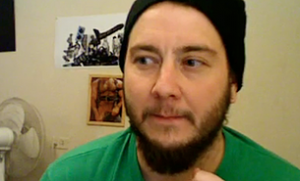In the service of developing a new vocabulary around the visibility of queer and trans people, the construction of “confessional” spaces needs to be reconfigured. The representation of the full spectrum of human gender is minimal in traditional broadcast media. YouTube is a medium that allows the entire range of gender to be expressed. From this point on, I will refer to this form as an autobiographical space. These YouTube videos are a movement in the documentation of the transgender context through this gender revolution. It is important to demonstrate this as a form of activism that is needed to bring awareness to trans issues.
Anthropologist and professor, Allen Feldman discusses how we are trained as people to disembody ourselves theoretically and analytically, which creates a tension between our own perspectives of self and the other. How do we begin to understand this? I believe that we are not getting any closer to achieving a fully integrated perception of self by creating autobiographical/therapeutic videos on a public website. The hyper-individualism that is characteristic of YouTube videos, of identifying oneself as a reflection of the other, begins to erase the auto understanding of self-identification.

a still shot from Kean’s documentary “FTM Searching”
Do these videos create a visibility for critical discourse then to be converted into progress toward a political goal? Or maybe these videos are THE political movement? FTM Search(ing) is the beginning of a documentary that structures the autobiographical spaces that female-to-male transgender people hold on a web-based video site. I have begun to create a narrative of these autobiographical spaces by weeding through many and editing each one to the exact line, telling the story, the facts.
When one types in “FTM passing” on YouTube and retrieves hundreds of videos of ftm people discussing passing and what that experience has been like for them, a narrative is created about that topic. I am structuring these categories (ftm passing, ftm pumping, ftm girlfriends, ftm body transition, ftm emotional transition, etc.) into chapters that are illustrated through these video clips of dialogue, in hopes of creating a conversation outside the space within which these videos originally exist. On a much larger level, FTM Search(ing) is a also a study of the linkage between new media and ftm trans spaces, and how complementary their parallel emergence is. New media allows otherwise marginalized communities to have dialog in a manner that is historically unprecedented.
As an artist, I am grappling with the ethical consequences of “outing” these exchanges from the community in which they exist. The temporal exchange with these videos on web pages now becomes a permanent position or voice in a documentary where the intention of the film’sviewer is that of witness to a social phenomenon. This piece creates position between these related places. Both of these spaces exist for similar reasons yet are used for different outcomes. The ways we approach these forms are for sexual investigation and/or autobiographical emotional development. The consciousness a subject holds is equal for both. The equality of the viewer, voyeur, and subject held by being the performer of these videos are with in the position of subjectivity. Subjectivity is defined as being dependent upon the mind or on an individual’s perception for its existence (Apple Dictionary), which allow us to connect the meaning of a witness to the idea of be objectification. Does one become objectified by their own representation of identity? Or rather do we objectify the informative “popular” personality on YouTube? To watch is to learn and to observe is to see more deeply. YouTube culture and space creates a language around looking at the private space in a public manner.
As a trans- male identified, female-bodied person I am interested in the language and experience around the recognition of “confessional” spaces for ftm transgender people on YouTube. How does the culture of visibility on the Internet change the agency of a person treating this space as a therapeutic hotline? I began this project by creating my own FTM Trans Vlogs (video blogs) on YouTube about my emotional and medical transitioning into maleness in 2005. I have watched hundreds of FTM vlogs and realized that the language used and affect of dialog is similar among most of the videos, almost as if there is a trend to follow when making these vlogs. As with all videos on YouTube there are ratings and number of views, which in my piece, “A Cellular Relation to Each One” I include for the importance of quantity of existence. My research for this piece was in my observation and analysis of these confessional videos. Through that research I realized that I wanted to make an installation piece that allowed these voices to be heard in a larger space than YouTube, as I find using YouTube as method of therapy controversial.
What is the relationship of the flesh self and the flesh other when one experiences cyberspace? We can look at others and in a mirror and see bounded entities commonly referred to as bodies (Wilson, Information Arts, 5). I, the viewer watch these guys’ videos and listen for something I think is interesting to transcribe for my performance. People, not specifically trans, who make videos and publish them to YouTube are exhibitionists and want or need to be seen; by watching their videos I am a subject of their exhibitionism just as much as they are a subject of my research. German art historian, Erwin Panofsky’s definition of subject, object also means individual, world, self and other. The power of image in society creates a disillusionment that people believe as the truth—which is where I find YouTube problematic as the instructional, therapeutic evidence of people’s experiences through videos. This structures a truth and encouragement to be seen however it is received, when perhaps that is not what should be said or advised.
The quantity and magnitude of distribution and views of videos are powerful. I am fascinated by W. J. T Mitchell’s discussion around ‘spectatorship’. He defines this as “the look, the gaze, the glance, and the practices of observation, surveillance, and visual pleasure” (Mitchell, Picture Theory, p.16). The origins of spectator are rooted in the French words ‘sur’, which means, ‘over’, and ‘veiller,’ which in Latin means to ‘keep watch’. I have been researching voyeurism as means to understand YouTube in a more intellectual way. Are we voyeurs, spectators, viewers (which is implied when we watch a video on YouTube as we are documenting a number of times viewed), or are we watching? Perhaps all of these. Appropriation evolves from observing.
In a work I produced in 2009 called “Jerk Off,” I have appropriated steryotypical cismasculine language instead of mimicking cismasculine actions. My desire to appropriate their masturbation techniques seems arbitrary. But it was intended as a means to understand where their fantasy lies, what it takes for them to get off, and how they talk about those things. The piece is single YouTube channel showing three screens with a black background. In two of the screens the viewer sees two men jerking off. Both only stay on screen until they finish coming then they disappear. The sound is choppy and cut up- only the sound of the questions being asked by me and their answers are heard. The farthest left screen is my head in profile with their images, repeating the words they say. Michael “Taking her bottoms off and slipping it in” Me “Taking her bottoms off and slipping it in” By appropriating their language I am generating a new level of understanding then I did from critically asking these men questions. I believe it also references my desire to be transgender rather then my failure of not having a penis. The only way I can attempt to appropriate their language is by watching, viewing and being voyeur to the act.

stills from “FTM Searching”
The definition of appropriation is “suitable for a particular person or place or condition, etc. or to take possession of by force, as an invasion” (Webster Dictionary). According to social critic and philosopher, Bertrand Russell, “knowledge is nothing but perception … Man is the measure of all things… Every thing is in a state of flux…” (Russell, History of Western Philosophy, p. 148). According to this understanding my perception of the construction of maleness is based on my own experience, not upon what I think or believe it to be as a socially constructed insight.
There is no way to identify maleness as an understanding, but rather an evolving construction based on pre-determined societal norms and understandings. There is a construction of a dynamic on YouTube that has created a community of men identifying and validating their emotional and physical presences in this sub community. Cisgender men learn to identify through societal male behavior, trans-men learn male behavior on YouTube, through watching other trans videos. There is something really interesting about this construction, a sub community has been formed by an appropriation of a construction, which is forming identification. To be apart of a political movement, which I believe this gender revolution is, is to then be a part of the creation of dialog surrounding trans-awareness. The dialog that exists is small and difficult to express to people outside the community, or at least is not considered common knowledge.
All these videos found under the umbrella of “FTM transitioning,” etc. are slated to become part of the language used to regard transgender people. The limited language found elsewhere on the internet is medical and/or psychological, whereas the videos posted by men transitioning are emotional. The emotional nature of these videos allows for the conversational connection and further engages intimacy. This gives way for the opportunity of correspondence among a community and is allowing of a therapeutic connection to be formed between related experiences. Perhaps, without the option of confiding in another person about ones’ development in a society that is unwilling for the most part, to engage in such progression, it is then possible to never feel supported or nurtured emotionally. Therefore, it is crucial this community exists on YouTube.
Bibliography:
Mitchell, W. J. T. Picture Theory. University of Chicago Press, 1995.
Russell, Bertrand. History of Western Sexuality. Routledge Press, London. 1946.
Wilson, Stephen. Information Arts: Intersection of Art, Science, and Technology. MIT Press, 2002.
[The final cut of "FTM Searching" will be published on Wild Gender once Kean releases it publicly in the spring 2013]
